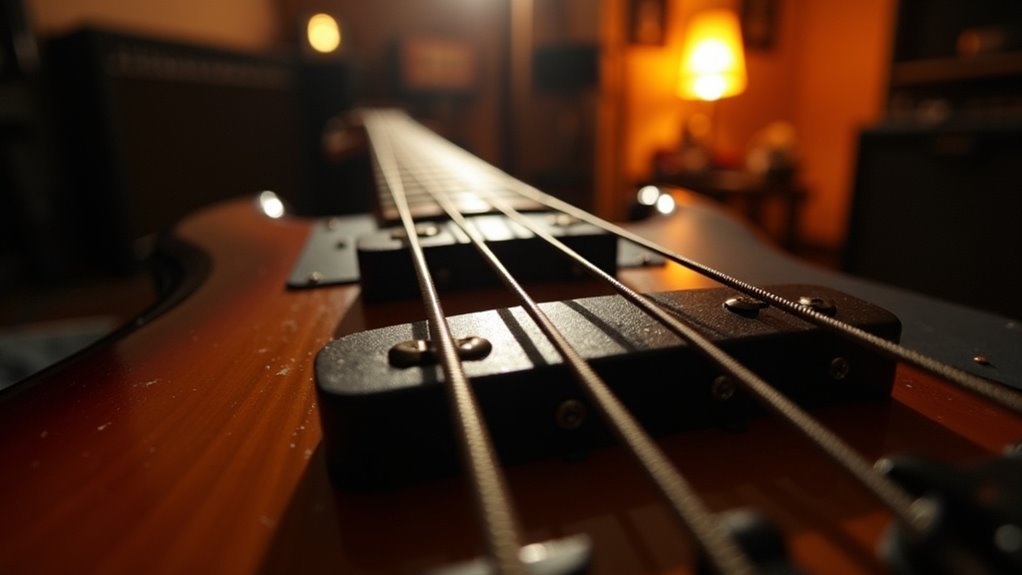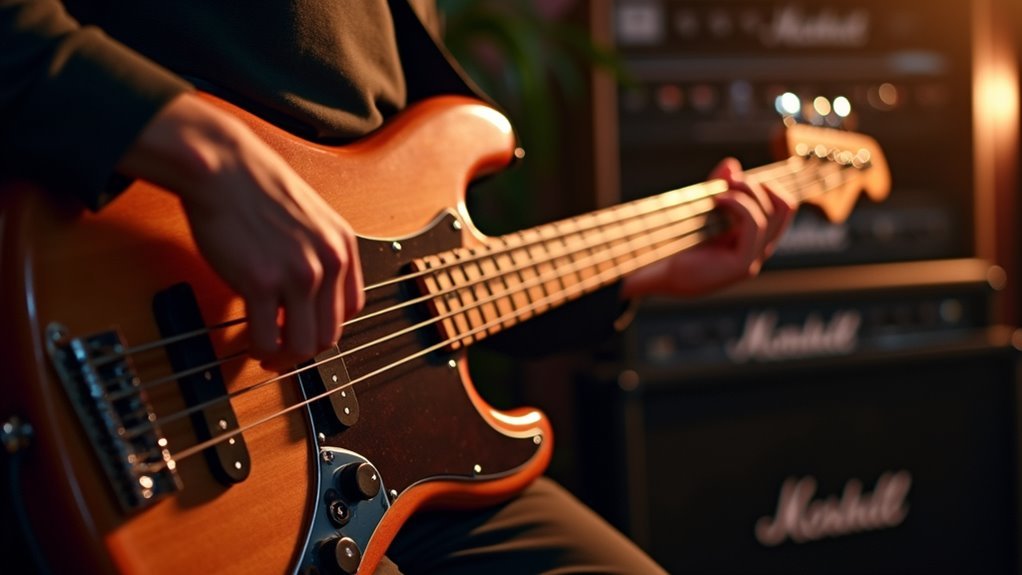Let’s lift the veil on one of bass guitar’s most enchanting secrets: harmonics. We’re not just talking about ordinary notes here – we’re exploring ethereal, bell-like tones that can transform your playing from basic to breathtaking. Whether you’re a seasoned player or just starting out, mastering harmonics will add an entirely new dimension to your musical toolkit. There’s a whole world of techniques waiting to revolutionize your sound.
Understanding Bass Guitar Harmonics: The Basics

When you’re ready to explore the sonic magic of bass guitar harmonics, you’ll need to understand the fundamental physics at play. Natural harmonics occur at specific points along your strings, creating ethereal sounds that float above the fundamental frequency.
We’ll focus on the most useful positions: the 12th, 7th, 5th, and 4th frets. Here’s the key – don’t press down. Instead, lightly touch the string at these points while plucking. The harmonic series emerges as bell-like tones, each a mathematical multiple of your open string’s pitch.
Lightly touch the strings at key fret positions without pressing down – let the natural harmonics ring out their crystalline overtones.
These harmonic pitches add incredible sonic texture to your playing. Master them, and you’ll reveal new expressive possibilities that transform your bass lines from ordinary to extraordinary.
It’s like having an extra gear in your musical toolkit.
The Science Behind Natural and Artificial Harmonics
The fundamental distinction between natural and artificial harmonics lies in how we manipulate string vibrations to create those ethereal overtones.
With natural harmonics, we’re lightly touching specific harmonic nodes on an open string – typically at the 4th, 5th, 7th, or 12th frets – letting the string vibrate in perfect mathematical segments.
Artificial harmonics require a different approach. We’re fretting a note first, then touching a node above it to create higher-pitched overtones.
It’s pure music theory in action: each harmonic produced follows the principles of integer multiples in the harmonic series. Your fretting hand’s precision is essential here – one millimeter off, and you’ll miss that sweet spot.
Master this technique, and you’ll reveal new expressive capabilities on your bass guitar that’ll transform your playing from basic to brilliant.
Essential Harmonic Shapes and Techniques

Five fundamental harmonic shapes serve as building blocks for advanced bass techniques. Let’s master these essential shapes using harmonics across different root notes. We’ll start with the E string, where 5th fret harmonics create deep, resonant foundations. Moving to C, we’re combining 5th fret harmonics for enhanced tonal quality in both major and minor progressions.
| Root Note | Fret Position | Sonic Character |
|---|---|---|
| E | 5th fret | Deep, resonant |
| C | 5th fret | Enhanced tonal |
| G | 4th to 7th | Warm, rich |
| Ab | 5th fret | Deep depth |
For G-based harmonics, we’ll slide from the 4th to 7th fret, creating warm textures. Ab and Bb shapes utilize 5th fret harmonics, perfect for dynamic bass lines and expanded harmonic possibilities in your compositions.
How to Tune Your Bass Using Harmonics
Mastering harmonic-based tuning transforms your bass guitar from an unwieldy beast into a precisely calibrated instrument.
Let’s explore with your A string as the reference point. To tune the E string, match the 7th-fret harmonic on A with the 5th-fret harmonic on E. For the D string, compare the 5th-fret harmonic on A with D’s 7th-fret harmonic. Finally, tune your G string by matching the 5th-fret harmonic on D with G’s 7th-fret harmonic.
Align your bass strings precisely by matching the harmonics: 7th fret to 5th fret, working methodically from A through G.
When you’re dialing in each string, listen for pulsating sounds – they’re telling you adjustments are needed. Keep tweaking until the harmonics stabilize into a clear, unwavering pitch.
Trust us, once you’ve got this method down, you’ll never look back.
Creating Chord Voicings With Harmonics

While many bassists limit themselves to single notes, you’ll reveal an entirely new sonic dimension by mastering harmonic chord voicings.
Let’s explore how natural harmonics can create complex chords on your bass guitar. Start with the basics: combine a D harmonic at the 7th fret (A string) with a G harmonic at the 5th fret (D string) for an Eb major 7th chord.
Want to switch things up? Move your root note to E, and those same harmonics now give you an E minor 7th chord, with the harmonics functioning as your minor third and seventh notes.
We can build rich harmonic textures by mixing fretted notes with harmonics across the fretboard. This technique isn’t just theory – it’s your ticket to creating unique voicings that’ll transform your bass lines in jazz, rock, or any genre.
Popular Songs and Artists Featuring Bass Harmonics
Let’s plunge into some legendary bass harmonics in popular music. Jaco Pastorius’s “Portrait of Tracy” stands as the definitive masterclass in bass harmonics, demonstrating their full expressive potential through a mesmerizing blend of natural and artificial techniques.
Jaco Pastorius revolutionized bass playing with Portrait of Tracy, weaving natural and artificial harmonics into an unprecedented tapestry of sound.
We’ll find Pink Floyd elevating the game on “Wearing The Inside Out,” where harmonics merge with stereo delay for extraordinary depth.
Dream Theater’s “Lifting Shadows Off A Dream” proves how harmonics create haunting atmospheres, while Pearl Jam’s “Jeremy” shows their raw power in a rock context.
These tracks span various genres, from jazz fusion to progressive rock, each revealing different aspects of harmonics’ melodic capabilities.
They’ve transformed the bass from a mere rhythm instrument into a versatile voice capable of leading the musical experience.
Frequently Asked Questions
Can You Do Harmonics on a Bass?
Over 90% of bassists use harmonics! We can play both natural harmonics and artificial harmonics on bass guitar through precise finger placement, creating bell-like tones that enhance our musical effects and bass riffs.
On What Frets Can You Play Harmonics?
We can play natural harmonics effectively on the 4th, 5th, 7th, and 12th fret positions along the fretboard. These locations produce clear harmonic series with ideal sound quality for various musical genres.
Can You Play Harmonics Anywhere on Guitar?
Holy smokes, we can play harmonics anywhere on the bass guitar! While natural harmonics work best at specific fretboard positions, artificial harmonics techniques let us create these magical tones at any spot.
How to Play Overtones on Bass?
To play overtones on bass, we’ll lightly touch nodal points at the 5th, 7th, or 12th fret, then pluck while quickly releasing. Proper finger placement and minimal string pressure create clear, ringing harmonics.